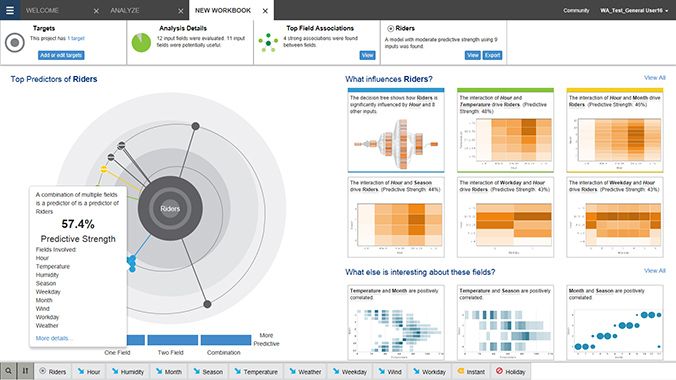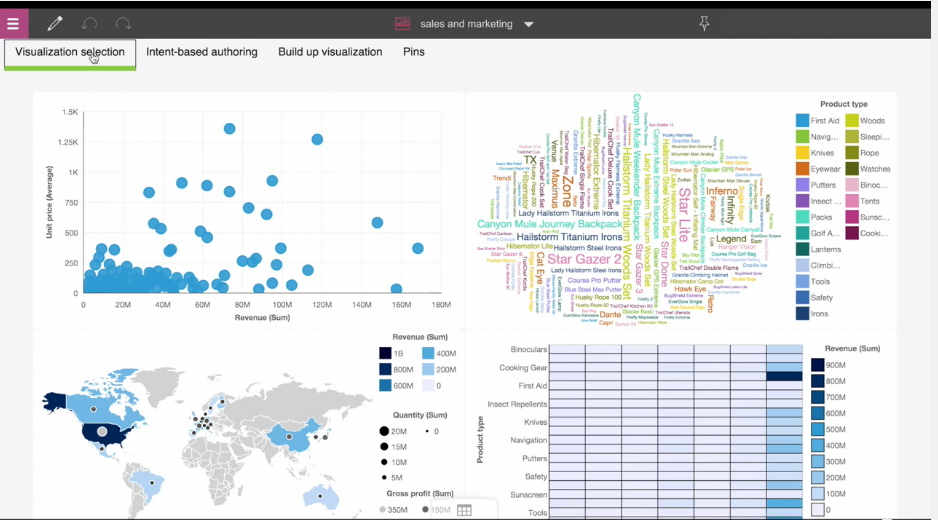
Vendor:
Founded:
Headquarters:
IBM
1911
Armonk, NY
Customers:
Deployment Model:
Free Trial:
26,000
Cloud
Yes
Watson Analytics At A Glance
Product Overview
NOTE: IBM Watson Analytics is no longer available for purchase. Instead, interested prospects can check out IBM Cognos Analytics.
IBM Watson strives to be much more than a reporting product. The supercomputer’s depth and intricacy is now accessible within Analytics, designed for any business user to quickly access through self-service.
Watson became famous after winning Jeopardy in 2011, and the machine has built on its intelligence to go as far as to help doctors diagnose lung cancer. With machine learning, it’s able to take in enormous amounts of data and teach itself to answer remarkable questions. Its natural language processing abilities allow it to make complex insights.
Watson software is now the backbone of many third-party applications such as Wayblazer, a travel concierge solution; Sell Smart, a mobile retail training app; and OrangeHRM, an open source HR solution.
Watson is especially good at parsing language on social media. In fact, it’s been jokingly referred to as a teenager. And it’s commonly known as one of the first forms of artificial intelligence.
Features
IBM Watson Analytics has the potential to replace many data science roles due to its simplicity. The following four features make this business solution appealing for users who have never before been able to make predictions from data:
1. Data Source: To start making predictions, users must first give Watson data. This is done through either dragging and dropping a data set in a spreadsheet or by making a selection from a third-party source such as Twitter or Salesforce. A quick filter helps sort data sources as they’re loaded into Watson.
2. Explore: Watson automatically asks questions about the loaded data while offering charts to answer those questions. This way, users have a starting point to ask their own questions and observe how Watson visualizes the data. Watson then suggests additional ways to visualize the data and draw comparisons (e.g., pie charts, bar graphs, scatter plots, maps or word clouds). They can then be saved and pinned for later analysis.
3. Predict: When users go to make a prediction about a data set, they’re able to rename the data set and add up to five targets from its fields. A diagram gives predictive strengths and visualizations that are populated based on the user’s targets. Decision trees help guide the user through wins and losses for future actions. A data quality report also scores the information to show the data’s quality by field and outliers. This information can be saved and pinned for later analysis as well.
4. Assemble: Watson gives users the ability to organize data that’s been loaded and saved with default layouts. By organizing the data this way, users can create dashboards and infographics about the data. Within this view, users can drag and drop any visualizations they’ve saved from before. Users can also create their own templates for presenting the data any way they like.
Target Market
While Watson Analytics is simple enough for any business user, it’s designed for certain industries such as banking, insurance, retail, telecommunications, government, nonprofit, education and chemicals manufacturing.
Business roles that best fit Watson Analytics include marketing, sales, IT, operations, HR and finance.
The following is a list of nine sample customers:
- Paschall Truck Lines (PTL)
- Mears Group
- Minter Ellison
- Caliber Patient Care
- Kristalytics
- Legends
- Iowa State University
- University of Memphis
- Mueller, Inc.
- Southern Connecticut State University
Free Report: Selecting The Right BI Vendor
 Choosing a BI vendor is all about finding the right fit. Our exclusive report will walk you through the process and help you select the perfect solution.Download Now
Choosing a BI vendor is all about finding the right fit. Our exclusive report will walk you through the process and help you select the perfect solution.Download Now
Implementation/Integration
As a cloud-based solution, implementation of Watson Analytics only involves registration and uploading data from a spreadsheet. Other data sources can be integrated with the solution, such as Twitter.
Tutorials and samples are paired with videos from the home screen to demonstrate navigation.
Customer Service & Support
The IBM Watson Analytics customer support team can be reached via live chat Monday through Friday from 8 a.m. to 5 p.m. Customer support will also respond to electronic support tickets.
Discussion boards are available to ask questions and connect with other users and IBM experts.
Additional resources include an expert blog and an assortment of customer stories, tips, brochures, webinars and videos.
Pricing
IBM Watson Analytics offer two pricing plans: Plus and Professional.
Plus: $30 per month
- Single-user access
- 2 GB of storage
- Relational database access
- 18 data connectors
- Twitter data access
Professional: $80 per user per month
- Accepts multiple users
- Includes all features of Plus
- 100 GB of storage
- Access to IBM Cognos reports
There is also a free 30-day trial that includes 1 MB of storage and basic access to IBM Analytics Exchange.

How Much Does A BI Tool Cost?
Download our free report to compare pricing on 12 popular BI solutions including Microsoft Power BI, Tableau, Alteryx, Qlik and more.Download NowShortcomings
The accuracy of IBM Watson Analytics relies on the user’s source data. The supercomputer does have a quality-reporting tool that shows inconsistencies in the data so users can evaluate the source.
When investing in a self-service tool such as Watson Analytics, there’s also a significant drawback concerning data governance. Decentralized reporting can mislead organizations when not properly balanced with the checks and balances of a governed system.
Screenshots
About
IBM Watson has a rich history leading up to its use as a business solution. It started out as a room-sized machine named after IBM’s founder, Thomas J. Watson.
Gradually, it has proven itself as a reliable predictive tool, entering many industrial and medical spaces to answer questions professionals were previously unable to answer.
Download Comparison Guide




